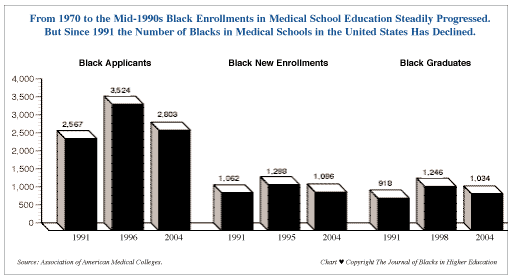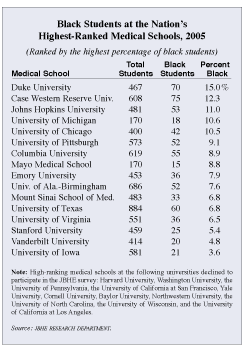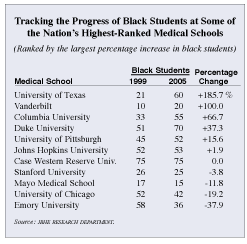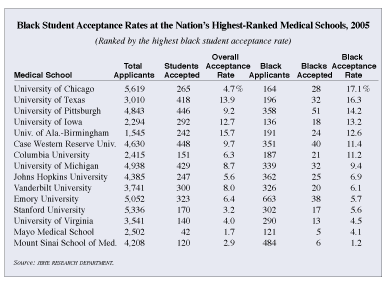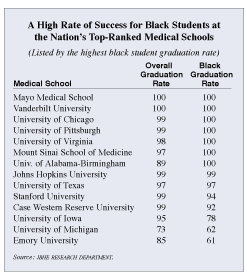| A JBHE Check-Up on Blacks in U.S. Medical Schools There is widespread agreement on the urgency in the United States of training more black medical professionals. But the bad news is that instead of an increasing number of blacks in medical schools, recent years have seen a significant drop in overall African-American enrollments in U.S. medical programs. The good news is that African Americans are making good progress at the nation's highest-ranked medical schools. And contrary to public beliefs, blacks who are admitted to these top medical institutions are graduating at a very high rate.This past September the Sullivan Commission on Diversity in the Healthcare Work-force, an independent public health effort funded by a grant from W.K. Kellogg Foundation, released an ominous report warning of an impending healthcare crisis in minority communities. The principal problem identified by the commission was the shortage of black and other minority healthcare providers. The Sullivan Commission, chaired by Louis W. Sullivan, president emeritus of the Morehouse Col-lege of Medicine and former secretary of the U.S. Department of Health and Human Services, concluded that while blacks, Hispanics, and American Indians make up more than 25 percent of the U.S. population, they are only 9 percent of the nation's nurses, 6 percent of the doctors, and 5 percent of the dentists. Also, blacks make up only 4 percent of all faculty members at American medical schools. But even this figure greatly overstates the picture because a very large number of these blacks who are called faculty members are practicing physicians who are affiliated with the medical school but who are almost never in the classroom.
Given these findings, it is important to assess the progress, if any, of blacks in American medical schools. Fifty-five years ago in 1950, only 133 blacks graduated from all U.S. medical schools. And the vast majority of these earned their medical degrees at the historically black medical schools at Howard University and Meharry Medical College in Nashville, Tennessee. These black medical school graduates made up a mere 2.4 percent of the 5,553 U.S. medical school graduates that year. In the late 1960s affirmative action programs became common at large numbers of traditionally all-white U.S. medical schools. As a result, the number of black medical school graduates increased more than threefold from 153 in 1969 to 571 in 1974. This progress slowed but continued steadily for most of the 1980s and 1990s. After a half-century of uninterrupted progress in black medical school enrollments and graduations, there has been a significant downturn in black enrollments in medical school education in the past several years. In 1996 black applications to medical school peaked at 3,524. By 2004 black applications to medical school had dropped to 2,803, a decrease of 20.5 percent. In 1995 black first-year enrollments in medical school reached an all-time high of 1,288. Since that time black first-year matriculations have dropped to 1,086. This is a decrease of 15.7 percent. Black graduates from medical school reached an all-time high of 1,246 in 1998. In 2004 there were 1,034 black graduates at U.S. medical schools. This is a decline of 17 percent from the 1998 high. Why has there been such a sharp decline in black applicants, enrollments, and completions at U.S. medical schools? There are a number of reasons. First is the fact that in recent years medical school enrollments have declined across the board for all ethnic groups including whites. Many college students — black and white — appear to have chosen to leave school after college in order to explore employment opportunities in law, business, and the high-tech sectors. Also, since the introduction of the burdens of managed care in the United States, medicine is no longer viewed as either a satisfying or high-paying profession. The practice of medicine is now viewed as a heavily regulated and often frustrating career. The rather sharp drop in black medical school enrollments also may be in part explained by the recession, which began in 2000, and probably the decline was worsened by the shock to the economy from the September 11, 2001 terrorist attacks. Under these circumstances, college graduates — particularly those from low-income families of which blacks make up a disproportionate number — may have been unwilling to commit to the many years required for medical school training. The huge income gap between black and white families is always a factor. The costs of medical school combined with the fact that the medical student will not be earning money for many years in the future may disproportionately persuade prospective black medical school students to pursue recently opened careers in business or law for which formal training will take less time.
Another reason for the large decline in black medical school enrollments may be legal prohibitions against race-sensitive admissions at state-operated medical schools in states such as California, Florida, and Washington. Other state-operated medical schools, although not barred by law from practicing race-sensitive admissions, have backed off from former strong affirmative action admissions policies in fear of legal challenges from right-wing groups that are pouring money into continuing litigation targeting racial preferences. Blacks Making Better Progress
While blacks as a whole have been withdrawing from medical education in the United States, a moderately different picture occurs when we examine African-American enrollments at the nation's highest-ranked medical schools. Recently, JBHE surveyed the nation's 25 highest-ranked medical schools requesting information on black applicants and enrollments. JBHE received data on black enrollments from 16 of the top 25 medical schools.
Of the medical schools in our count, Duke University has the highest percentage of black students. The 70 black medical school students at Duke make up an impressive 15 percent of the student body. There are 75 black medical school students at Case Western Reserve University in Cleveland. They make up 12.3 percent of all students at this top-ranked medical school. Blacks are also more than 10 percent of the student body at high-ranking medical schools at Johns Hopkins University, the University of Michigan, and the University of Chicago. Among the leading medical schools that responded to the JBHE survey, only Vanderbilt University and the University of Iowa had a student body that was less than 5 percent black. At many of the nation's leading medical schools that are included in the JBHE survey, there has been solid progress in increasing black enrollments over the past six years. At the University of Texas, which had been legally barred from using race-sensitive admissions during the seven-year period from 1996 to 2003, black enrollments have nearly tripled since 1999. Today, there are 60 black medical students at the University of Texas making up nearly 7 percent of the student body. In 1999 there were only 21 black medical school students at the University of Texas. The number of black medical school students at Vanderbilt University has doubled during the 1999 to 2005 period. Yet blacks are still only 4.8 percent of all students at the Vanderbilt medical school. The medical schools at Columbia University and Duke University have also posted significant gains during the six-year period. For reasons that we have not been able to determine, the largest decline in black enrollments has occurred at the medical school at Emory University in Atlanta. There, the number of blacks enrolled in medical studies decreased by a huge 38 percent from 58 in 1999 to 36 today. The University of Chicago also showed a significant drop in black medical school enrollments during the period. Black Acceptance Rates at Leading Medical Schools
Medical school is perhaps the most difficult entrance ticket to obtain in higher education. As expected, this is particularly true at the nation's highest-ranked medical schools. At the 15 medical schools for which we have acceptance rate data, 12 of the schools accepted less than one in every 10 applicants. At the medical school at Stanford University, fewer than one in every 30 applicants were accepted for admission. At the highly esteemed Mayo Medical School in Rochester, Minnesota, only 42, or 1.7 percent, of the more than 2,500 applicants were accepted for admission. For blacks the acceptance rate at seven of the 15 schools that responded to the JBHE survey is greater than 10 percent. At 11 of the 15 schools the black acceptance rate is higher than the overall acceptance rate. This may reflect strong affirmative action admissions aimed at increasing the number of blacks in the medical profession. On the other hand, the high acceptance rate may simply show that the particular medical school attracted a very high caliber of black applicant. At most of the medical schools in our survey the black acceptance rate varies only slightly from the overall acceptance rate. But there are exceptions. At the University of Chicago, more than 17 percent of black applicants were accepted for admission in 2004. This is more than three times the acceptance rate for students of all races, which stood at 4.7 percent. At Columbia University 11.2 percent of all black applicants were accepted. This is nearly double the overall acceptance rate of 6.3 percent. At the medical schools at the University of Alabama at Birmingham, Vanderbilt University, Emory University, and the Mount Sinai Medical School of Medicine, the overall acceptance rate was higher than the acceptance rate for blacks. At Mount Sinai only 1.2 percent of all black applicants were admitted to the medical school. Black Student Graduation Rates at
Nationwide, the mean score on the Medical College Admission Test (MCAT) of black students who are accepted to medical schools is substantially lower than the mean score on the MCAT of white students who are rejected for admission. These rather startling statistics lead conservative opponents of affirmative action to contend that medical schools are admitting a large number of black students who are unqualified to handle the rigorous science-oriented curriculum at these schools.
But graduation rates distinctly refute this position. Data collected by JBHE shows that at the vast majority of the nation's leading medical schools, the black graduation rate is very high. In fact, at seven of the 14 schools that supplied graduation rate data by race to JBHE, the black graduation rate was a perfect 100 percent. The seven high-ranked medical schools with a black graduation rate of 100 percent are the Mayo Medical School, Vanderbilt University, the Uni-versity of Chicago, the University of Pittsburgh, the University of Virginia, the Mount Sinai School of Medicine, and the University of Alabama at Birmingham. At four additional high-ranking medical schools the black graduation rate is 92 percent or better. They are the highly prestigious medical schools at Johns Hopkins University, Stanford University, Case Western Reserve University, and the University of Texas. But all the news is not good. The black graduation rates at the medical schools at the University of Iowa, the University of Michigan, and Emory University are not only low, but the black graduation rates at these three medical schools are significantly below the rates for whites.
Black Faculty at the Nation's Leading Medical Schools Finally, let's check on the number of blacks in teaching positions at the nation's major medical schools. The presence of black mentors and role models on medical school faculties is invariably seen as an important factor in attracting black students and in encouraging blacks to seek medicine as a career. At most of the leading medical schools, blacks have only a minute presence in faculty ranks. In fact, at 12 of the 14 medical schools that supplied information to JBHE, blacks were 3 percent or less of the total faculty at these schools. The only exceptions were the medical schools at Columbia University and Emory University. At Columbia 9.9 percent of the faculty is black. At Emory the 131 black faculty members at the medical school make up 7.2 percent of the total faculty. But remember that large numbers of blacks who are listed as faculty members are merely practicing physicians who are affiliated with the medical school. Most do not actually teach in the classroom. Also, note that these two medical schools are located in major urban areas with large black populations. Therefore, these two medical schools can tap into the large pool of black physicians who have set up practice in these cities to serve the large African-American populations. Nevertheless, other leading medical schools such at Johns Hopkins, the University of Chicago, the University of Alabama at Bir-mingham, Mount Sinai, and Case Western Reserve University also operate in cities with large black populations and presumably a significant number of black physicians. But these medical schools have very small percentages of blacks on their faculties. When we examine tenured faculty members, the presence of blacks is even more rare. At all 14 schools that supplied data to JBHE, blacks are 2 percent or less of the total tenured faculty at these schools.
In tenure rankings, the University of Alabama at Birmingham leads the list. It has six tenured blacks on its faculty, 2 percent of its total tenured faculty. At the University of Michigan there are 14 blacks with tenure on the medical school faculty. But they make up only 1.8 percent of the total tenured faculty. At six of the 14 medical schools in our survey, blacks are less than one percent of the tenured faculty. These schools are Case Western Reserve University, the University of Iowa, the University of Texas, Mount Sinai School of Medicine, Stanford University, and Columbia University. As noted earlier, the medical school at Columbia University had the highest percentage of blacks among its total faculty. But there are 189 faculty members at Columbia who hold tenure. Not one of them is black. | |




